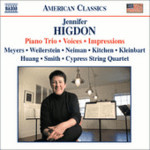
Higdon: Piano Trio / Voices / Impressions
 $25.00
Low Stock
add to cart
$25.00
Low Stock
add to cart
JENNIFER HIGDON
Higdon: Piano Trio / Voices / Impressions
Cypress String Quartet
[ Naxos American Classics / CD ]
Release Date: Tuesday 2 January 2007
Should this item be out of stock at the time of your order, we would expect to be able to supply it to you within 2 - 5 business days.
Jennifer Higdon's philosophy in composing is simple: make sure the music communicates. It is her goal to write music that speaks not only to the seasoned professional performer, but also to audiences that come to this music with all types of understanding, from the first-time listener to the most sophisticated Classical connoisseur.
Jennifer Higdon started late in music, teaching herself to play the flute at the age of fifteen and then beginning formal musical studies at eighteen, with an even later start in composition at the age of 21. Despite this late start, she has become a major figure in contemporary classical music and is able to make her living from commissions and on average completes between five and ten pieces a year. These works run the range of genres from orchestral to chamber, and from choral to vocal. She is the recipient of many awards, including a Pew Fellowship, a Guggenheim Fellowship and two awards from the American Academy of Arts and Letters. In the summer of 2003 she was the first woman to be a featured composer at the Tanglewood Contemporary Music Festival. The 2005 Van Cliburn Competition also featured her work, Secret and Glass Gardens as part of its semi-final rounds. Her commissions have included works for such major groups as the Philadelphia Orchestra, the Atlanta Symphony, the Dallas Symphony, the Indianapolis Symphony, National Symphony, the Pittsburgh Symphony, and the St. Paul Chamber Orchestra; for the new music ensemble, eighth blackbird, the Tokyo String Quartet, the Ying Quartet, and the Lark Quartet; and for such soloists as Colin Currie, Gary Graffman and Lang Lang. Jennifer Higdon's works enjoy more than one hundred performances annually. Her orchestral work, blue cathedral, has become one of the most performed contemporary orchestral works in the United States. Her music appeals to a wide-ranging audience in both classical experience and age. Matt Groening, creator of the popular The Simpsons series, singled out her disc, the Grammy-award winning Higdon: Concerto for Orchestra/City Scape, as one of his top-ten favorites of 2004. She is on the composition faculty at the Curtis Institute of Music in Philadelphia.
Composer's Notes
Can music reflect colors and can colors be reflected in music? I have always been fascinated with the connection between painting and music. In my composing, I often picture colors as if I were spreading them on a canvas, except I do so with melodies, harmonies and through the peculiar sounds of the instruments themselves. The colors that I have chosen in both of the movement titles of my Piano Trio, Pale Yellow and Fiery Red, and in the music itself, reflect very different moods and energy levels, which I find fascinating, as it begs the question, can colors (in music, word and painting) actually convey a mood? The work was commissioned by the Bravo! Vail Music Festival.
Voices is the telling of three different images. The first image, Blitz, carries a tremendous amount of relentless, frenzied energy. It describes a high level of intensity, always on the verge of explosion. The second image, Soft Enlacing, carries a much more vague meaning, and is a calming contrast from the first movement. It may be very much like a walk through the house in the middle of the night: while the floor feels solid under foot, the rest of the world, to the eyes and ears, seems to be moving shadows. It may also be a gentle hug or the warm emotional embrace of a loved one. Again, its image is not meant to be clear-cut and depends upon the listener's 'viewing'. The final movement, Grace, is the calmest and carries the greatest possible number of meanings: the giving of thanks at a meal; the grace seen in behavior or in a personality; grace in one's movement; the bestowing of one's self unto others; the quiet presence that exists in a being's soul. The telling of these images is from manic and frenzied to calm and quiet, from specific to vague, and from dark to light. Voices was commissioned by the Philadelphia Chamber Music Society.
Impressions is a musical response to the artists of the Impressionist period in both music (Debussy and Ravel) and painting (Monet and Seurat). This work, like the Debussy and Ravel quartets, is in four movements. Bright Palette, the first movement, refers both to the bright harmonic language of these composers and the brilliance of the paintings from this era, where light and brighter colors are the focus. The second movement, Quiet Art, is about the solitude in which artists work, and the passion and consistency that help to create a work of art. To The Point is a direct response to the Debussy and Ravel second movements, which address the Gamelan of the 1889 World Exposition (the use of 'point' in the title also refers to the tip of the brush in the pointillistic painting style used in the Impressionist era). The final movement, Noted Canvas is a musical portrait of painting (in tribute to the many well-known canvases from this period). The chromatic, edgy language reflects the intensity of the Ravel fourth movement, and one of the motives is shaped similarly to one of the principal themes from the fourth movement of the Debussy. Musical materials from both the first and second movements are recalled in tribute to these two composers' craftsmanship in their own thematic development. Impressions was commissioned by the Cypress String Quartet.
Tracks:
Impressions
Piano Trio
Voices
